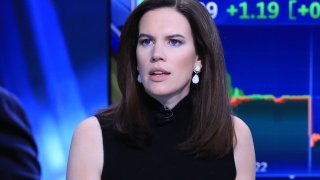
Kelly Evans, CNBC
Before we dive in, let's all pause to remember the late great Charlie Munger's maxim that events are often the result of multi-cause "lollapaloozas," and not singular developments. It's why people are still arguing over what "caused" the Great Financial Crisis (it was Fannie and Freddie! No--it was the banks! No--it was the Fed!) when in reality all of that had to happen for it to happen, if that makes sense.
With that in mind, let's review the carnage currently playing out in global markets. Starting in Japan, where things are pretty ugly. Today's 12% plunge was the worst day for their TOPIX market since the 1987 crash. And it was already down sharply at the end of last week. The three-day, 20% total drop is now the worst on record since 1949, per Deutsche Bank's Jim Reid. It's a pretty damning indictment of the Bank of Japan's decision to hike rates last Wednesday (the same day our Fed held them steady).
Since Japan's decision to hike rates, the yen--which had been so cheap you could score a top Tokyo hotel room for about $87 in July--has soared in value, upending the so-called "carry trade." Traders globally love to "borrow" in cheap yen and go long momentum plays like Big Tech. But the surging yen, on top of bad reactions to Big Tech earnings starting with Alphabet's on July 23rd, has upended that lucrative trade. News this weekend that Berkshire has sold half of its "tentpole" Apple position didn't help--Apple is down 5% today, and the "Mag 7" is now down 20% from their July 10th highs.
The panic has happened so quickly that the market's own "fear gauge" of volatility, the VIX, has soared from under 12 a month ago to 65 this morning. That, along with the speed of the plunge in bond yields, is triggering calls for immediate Fed intervention. The Fed's Goolsbee has already been messaging this morning that if the economy deteriorates--because the weaker jobs report Friday is also factoring in here--the Fed will "fix it." I wouldn't be surprised, after seeing the Fed have to upsize to a 75-basis-point hike for their first upwards move in June 2022, to see the exact same thing on the way down; a 75-basis-point "catch up" cut in September.
Get top local stories in San Diego delivered to you every morning. Sign up for NBC San Diego's News Headlines newsletter.
It's the Bank of Japan's possibly errant rate hike, in other words, coming at the same time the U.S. economic data is slowing that is throwing markets into havoc. We do seem to be following the playbook many like Nancy Lazar, Michael Kantrowitz (both of Piper Sandler), Michael Darda and others have been warning about: Fed hikes finally taking hold after about a two-year lag, and the yield curve warning signal being proven right yet again.
But wait, the yield curve is finally disinverting! Isn't that a good sign? No. The inversion (when the 10-year yield goes below the 2-year or 3-month yield) tells you a recession is coming; the disinversion, when short ends yields start plunging, typically means the recession is actually upon us. The two-year yield was over 5% at the end of April; it has since plunged to 3.8% as the market prices in more Fed cuts and a slowing economy. This is similarly why analysts like Michael Hartnett at Bank of America warn you should typically "sell the first cut."
So what now? "My only fear is a resurgence in inflation," David Zervos of Jefferies wrote in a client note this morning, "which in turn handicaps the Fed's ability to act if economic weakness deepens." For instance, if the core CPI rises 0.3 points or more last month, which we'll find out next Wednesday. If it remains tame, up just 0.1 or lower, "[that] will be an all-asset ripfest as super-sized Fed cuts will be further priced into the market," he added.
Money Report
In the meantime, those who hung onto their poorly performing bonds the past couple years will probably now be greatly relieved to have them in their portfolios.
See you at 1 p.m!
Kelly

